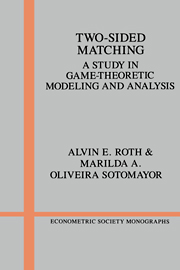Book contents
- Frontmatter
- Chapter 1 Introduction
- Part I One-to-one Matching: the Marriage Model
- Part II Many-to-one matching: models in which firms may employ many workers
- Chapter 5 The college admissions model and the labor market for medical interns
- Chapter 6 Discrete models with money, and more complex preferences
- Part III Models of one-to-one matching with money as a continuous variable
- Part IV Epilogue
- Bibliography
- Name Index
- Subject index
Chapter 5 - The college admissions model and the labor market for medical interns
from Part II - Many-to-one matching: models in which firms may employ many workers
Published online by Cambridge University Press: 05 January 2013
- Frontmatter
- Chapter 1 Introduction
- Part I One-to-one Matching: the Marriage Model
- Part II Many-to-one matching: models in which firms may employ many workers
- Chapter 5 The college admissions model and the labor market for medical interns
- Chapter 6 Discrete models with money, and more complex preferences
- Part III Models of one-to-one matching with money as a continuous variable
- Part IV Epilogue
- Bibliography
- Name Index
- Subject index
Summary
The formal model
There are clear similarities between the hospital intern market and the simple model of a marriage market studied in the previous chapters. There are two kinds of agents, hospitals and medical students, and the function of the market is to match them. (Strictly speaking, we should speak of hospital programs rather than hospitals, because different internship programs within a hospital are separately administered, and students apply to specific programs.) Because interns' salaries are part of the job description of each position, and not negotiated as part of the agreement between each hospital and intern, salaries will not play an explicit role in our model, but will simply be one of the factors that determine the preferences that students have over the hospitals. Similarly, we will assume that hospitals have preferences over students - that is, they are able to rank order the students who have applied to them for positions, as they are asked to do by the National Resident Matching Program. The major difference from the marriage problem is that each hospital program may employ more than one student, although each student can take only one position. (All the positions offered by a given hospital program are identical, since hospitals offering different kinds of positions must divide them into different programs.) The rules of the market are that any student and hospital may sign an employment contract with each other if they both agree, any hospital may choose to keep one or more of its positions unfilled, and any student may remain unmatched if he or she wishes (and seek employment later in a secondary market).
- Type
- Chapter
- Information
- Two-Sided MatchingA Study in Game-Theoretic Modeling and Analysis, pp. 125 - 170Publisher: Cambridge University PressPrint publication year: 1990

